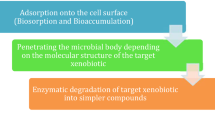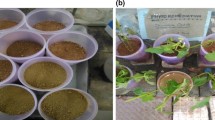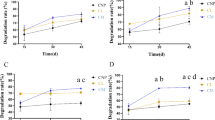Abstract
The number of colony-forming units of microorganisms, the viable biomass, and also the intensity of the microbiological processes (respiration, nitrogen fixation, denitrification, and cellulose decomposition) in playa solonchaks and sandy-loamy filled grounds in the territory of the Severnye Buzachi Oilfields (Kazakhstan) were much lower than in other soil types attesting to the limited capability of these substrates for selfpurification. Upon pollution by oil at concentrations of 100–600 mg/kg, the number of copiotrophic bacteria increased, whereas the actinomycetal and fungal populations were reduced and the biomass pool, the rates of CO2 emission, the potential nitrogen fixation, and denitrification became higher. The microbial communities of the playa solonchaks were weakly active and consumed few applied substrates. The biotesting with Artemia salina L. showed that some areas belonged to the lands of the 4th danger class, although the majority of the soil and substrate samples were not toxic. The germination of Lepidium sativum L. seeds was suppressed because of the salt toxicity, which is not related to the oil concentration (30 to 600 mg/kg).
Similar content being viewed by others
References
M. V. Gorlenko and P. A. Kozhevin, Multisubstrate Testing of Natural Microbial Communities (Maks-Press, Moscow, 2005) [in Russian].
V. B. Dambaev, “Propagation of Destructor Bacteria in Transbaikalian Solonchaks,” in Proceedings of the 9th International Pushchino School-Conference of Young Scientists “Biology, a Science of the 21st Century,” (Pushchino, 2005), p. 27.
G. A. Zavarzin, T. N. Zhilina, and V. V. Kevbrin, “Alkaliphilic Microbial Community and Its Functional Diversity,” Mikrobiologiya 68, 579–599 (1999).
G. M. Zenova, G. V. Oborotov, and D. G. Zvyagintsev, “Solonchaks: The Ecotopes of Halophilic and Alkalotolerant Streptomycetes,” Pochvovedenie, No. 11, 1341–1344 (2005) [Eur. Soil Sci. 38 (11), 1190–1193 (2005)].
N. M. Ismailov, “Microbiological and Enzymatic Activity of Oil-Contaminated Soils,” in Remediation of Oil-Contaminated Soil Ecosystems (Moscow, 1988) [in Russian].
E. L. Kvasnikov and T. M. Klyushnikova, “Transformation of Oil Hydrocarbons in the Biosphere,” in Proceedings of the Republican Conference “Structure and Functions of Microbial Communities in Soils with Different Anthropogenic Loads,” Chernigov, 1982 (Naukova Dumka, Kiev, 1982), pp. 5–8 [in Russian].
I. A. Klimenko, Environmental Conservation during the Exploration and Development of Oil Fields: Review of the All-Union Research Institute of the Economy of Mineral Raw Materials and Geological Exploration (VIEMS, Moscow, 1987) [in Russian].
Yu. E. Kozlova, Candidate’s Dissertation in Biology (2005).
A. V. Kurakov and V. S. Guzev, A.L. Stepanov, et al., “Mineral Fertilizers as a Factor of Anthropogenic Impact on Soil Microflora,” in Microorganisms and Soil Conservation (Mosk. Gos. Univ., Moscow, 1989), pp. 47–85 [in Russian].
A. V. Kurakov, V. V. Il’inskii, S. V. Kotelevtsev, and A. P. Sadchikov, Bioindication and Rehabilitation of Ecosystems during Oil Contamination (Grafikon, Moscow, 2006) [in Russian].
A. V. Kurakov and T. G. Tynybaeva, “Monitoring of Contamination of Solonchaks and Filled Grounds with Heavy Metals and Arsenic in the Working Areas of the Northern Buzachi Gas and Oil Field, Kazakhstan,” Vest. Mosk. Univ., Ser. 17: Pochvoved. (in press).
O. V. Menyailo, Extended Abstract of Candidate’s Dissertation in Biology (1996).
O. V. Menyailo, A. L. Stepanov, and M. M. Umarov, “Effect of Salts on the Denitrification Product Ratio in Soils,” Pochvovedenie, No. 3, 316–321 (1998) [Eur. Soil Sci. 31 (3), 288–292 (1998)].
O. V. Menyailo, A. L. Stepanov, and M. M. Umarov, “The Transformation of Nitrous Oxide by Denitrifying Bacteria in Solonchaks,” Pochvovedenie, No. 2, 213–215 (1997) [Eur. Soil Sci. 30 (2), 178–180 (1997)].
Methods of Soil Microbiology and Biochemistry, Ed. by D. G. Zvyagintsev (Mosk. Gos. Univ., Moscow, 1991), pp. 47–58 [in Russian].
V. G. Mineev, Laboratory Manual on Agricultural Chemistry (Mosk. Gos. Univ., Moscow, 2001) [in Russian].
Environmental Impact Assessment of the North Buzachi Oilfield Facility Construction during the Pilot Commercial Development (Texaco North Buzachi, Aktau, 1998), pp. 30–44 [in Russian].
Environmental Impact Assessment of the Second Stage of North Buzachi Oilfield Facility Construction during the Pilot Commercial Development (Aktau, 2000), pp. 45–60 [in Russian].
Report on the Results of Monitoring the North Buzachi Oil and Gas Field (Tandem, Aktau, 2005), pp. 4–10 [in Russian].
A. A. Titlyanova, N. A. Afanas’ev, N. B. Naumova, et al., Successions and the Biological Cycle (Nauka, Novosibirsk, 1993) [in Russian].
T. G. Tynybaeva and A. V. Kurakov, “Chemical and Microbiological Properties of Oil-Contaminated Solonchaks in the North Buzachi Oil Field,” Dokl. Mosk O-va Isp. Prir. 39, 166–172 (2006).
K. Sh. Faizov, Soils of the Kazakhstan Desert Zones (Alma-Ata, 1983) [in Russian].
FR 1.39.2006.02 505 Biological Methods of Controls. Procedure of Determining the Toxicity of Highly Saline Surface Water, Sewage, Soils, and Wastes by the Survival of Maxillopods Artemia salina (Mosk. Gos. Univ., Moscow, 2006) [in Russian].
E. Bilanenko, D. Sorokin, M. Ivanova, and M. Kozlova, “Heleococcum alkalinum, a New Alkali-Tolerant Ascomycete from Saline Soda Soils,” Mycotaxon 91, 497–507 (2005).
E. N. Bilanenko and M. L. Georgieva, “Haloalkalitolerant Community of Micromycetes Inhabiting Soda Solonchaks,” in Proceedings of the XVI Symposium of Mycologists and Lichenologists of Baltic States, Cesis, Latvia, 2005 (Cesis, 2005), pp. 52–55.
Author information
Authors and Affiliations
Corresponding author
Additional information
Original Russian Text © T.G. Tynybaeva, N.V. Kostina, A.M. Terekhov, A.V. Kurakov, 2008, published in Pochvovedenie, 2008, No. 10, pp. 1258–1267.
Rights and permissions
About this article
Cite this article
Tynybaeva, T.G., Kostina, N.V., Terekhov, A.M. et al. The microbiological activity and toxicity of oil-polluted playa solonchaks and filled grounds within the Severnye Buzachi Oil Field (Kazakhstan). Eurasian Soil Sc. 41, 1115–1123 (2008). https://doi.org/10.1134/S1064229308100141
Received:
Published:
Issue Date:
DOI: https://doi.org/10.1134/S1064229308100141




